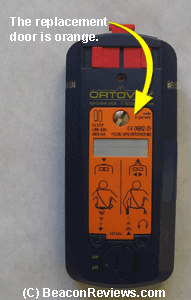
Ortovox recalled the M1 and M2 due to a problem with variances in battery sizes.
Most of the replacement doors that I have seen are orange (as shown in this illustration). I asked Ortovox how you can tell if you have the old or new door, but I did not receive an answer.
The following comments appeared on the Mountain Rescue Association's mailing list in January, 2005. They provide background information on the problem.
Subject: AA batteries and Ortovox M2 shutdown.
I caught wind that a couple of our local guides were having problems with their M2 shutting off when the unit took anything more than a moderate knock, such as striking it in your palm. Initially we thought it was the same problem the M1's had with to much slop in the battery compartment which Ortovox fixed with the M2. They dealt with this issue by increasing the size of the battery pressure tabs on the inside of the compartment door.
Three of us use M2's so we tried to duplicate the problem. We could get the batteries to shift, but no where near enough to shut off the unit. I was able to get hold of one of the guide's M2 and sure enough we got the unit to shut off. After some trouble shooting it came down to the specific size of the batteries. After getting 6 or 7 different manufactured AA batteries side by side they were all a bit different in size. The largest and the smallest was actually quite substantial. The other issue was the height of the + (positive) nub on the top of the battery as well as the - (negative) contact on the bottom.
The best battery for the M2, of the ones we looked at, was the Duracell Coppertop due to its large diameter and longer length. The negative terminal also protrudes from the bottom while many are either flush or indented. The M2 compartment tolerances are so tight that batteries 1mm shorter or thinner at times was enough to make a difference to shut off the unit. I was able to shut the M2 down with no trouble with more than one manufactured battery.
The original problem battery was an Energizer alkaline and one of the smallest batteries was the GSA contracted Kodak alkaline AA that many government employees might be using. I never gave much thought to the size changing from battery to battery, but in this application the consequence could be substantial. I have some additional thoughts about exactly why and how the small batteries fail. The short of it is use the most robust AA you can find that is wide, long, and has large terminal ends. Chris
Christopher P. Joosen
Lead Snow Ranger/Dispersed Recreation Supervisor Director
Mount Washington Avalanche Center
White Mountain National Forest